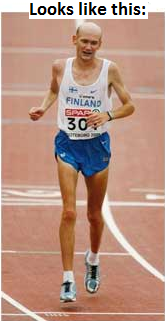Day 3
Originally, I meant to fly back to Boston after the seminar had finished, but after I got back to the hostel on day 2 – I saw that my flight had been cancelled.
So, I got up nice and early to try and rectify the situation – to no such luck.
I had another very casual, last minute exit from the hostel to begin the final day of the seminar.
Vern Gambetta – Teaching speed: Theory and application
Vern Gambetta discussed the development of linear speed in athletes of all ages. Most of his work has been with track athletes, although some of it may be relevant to those in team sports – as achieving top speed can be desirable in some cases:
In addition, training top speed can help reduce the incidence hamstring injuries.
When training for speed development, it’s important to make sure that the mechanics are perfect, as only ‘perfect practice makes perfect’. The coach must be able to justify every drill that is prescribed to the athlete, and in many cases Vern had seen young athletes attempt to copy more advanced sprinters. Unfortunately, the drills that they copied were way too advanced and the young athletes used poor technique, which could ultimately hinder performance.
Lesson 1 – The arms get rid of rotation during sprinting, thus provide energy into the system. This can justify training the upper body to enhance speed development
Lesson 2 – When racing – you need to win the race, not just the start
Lesson 3 – Contrary to popular belief, the arms do not remain at 90° during sprinting. The elbow angle decreases when the arm comes forward and opens up at the back – forcing the athlete to stay at 90° may be detrimental to performance
Charles Staley – Olympic-stlye weightlifting simplified (lecture)
Charles Staley is passionate about Olympic lifting – he wouldn’t be training otherwise.
He discussed the appropriate progressions that can be used to teach the Snatch and the Clean and Jerk and went into detail the mechanics of each lift.
A key reason he thinks that they are great for athletes, is that they’re ‘fun’ to perform. Anything that is fun to do is likely to result in greater adherence – and this is an underrated factor when it comes to training. He noted that when you hit a golf ball with perfect precision, you feel it. The same can be said about the Olympic lifts and so it can be used as a tool to get people to really engage with their training.
An important point that we were taught to understand was that the O-lifts will not necessarily induce performance enhancement in all sports - contrary to the belief of weightlifting coaches who think it will fix any sport.
Lesson 1 – If you’re using the Olympic lifts to enhance power development – you MUST be technically proficient – otherwise they’re a waste of time.
Lesson 2 – Don’t coach the errors that don’t exist – only make improvements on what needs to be improved.
Charles Staley – Olympic-stlye weightlifting simplified (practical)
His practical followed his lecture, teaching us how to appropriately perform the O-lifts.
I really liked his calm method of teaching and actually picked up a few hints that instantly made my technique better. I have had a large number of lessons in Olympic lifting and by far was his the easiest to follow.
We were first taught the clean and jerk, which according to Charles, is easier for most athletes, and comfort with this lift translates into easier learning for the snatch.
He had us first being able to rack the bar. This is the most important part and should always be taught first, as an athlete who can’t rack the bar, won’t be able to clean properly.
We then performed the ‘transition phase’ for 2 reps, before explosively going into triple extension. He had us to this so that we should be create a desire to try and catch the bar – despite not telling us to.
We then followed the same procedures for the snatch
Lesson 1 – A key difference between the clean and the snatch is that in the clean, the bar will bounce off the thighs, whereas in the snatch, the bar should slide up the thighs and into the hip (don’t hit your
junk!)
Lesson 2 – After performing cleans, up the weight and perform some clean pulls. Following these, up the weight further – you are now perfectly warmed up for deadlifts.
I will definitely try and be back next year – the quality and quantity of the information gained is second to none.
As I found out earlier, thanks to Hurricane Irene, my flight was cancelled and initially I had to wait a week in California until I could fly back. The hostel is in the middle of no-where and since Gustavo left (in his car) I wasn’t even sure if I could buy food from anywhere.
On my first day of doing nothing, I took the time to take these nice photos of the Pacific ocean though:
So time well spent...
Fortunately, before exhausting my photo taking capabilities forever, I was able to get on a flight early Tuesday morning.
So 3 buses, a taxi (because I got lost), 1 flight, a 4 hour wait in Texas, another flight, 2 trains, another bus and a lift in a truck with a Brazilian stranger – I arrived safely back in Boston.
Easy.
























